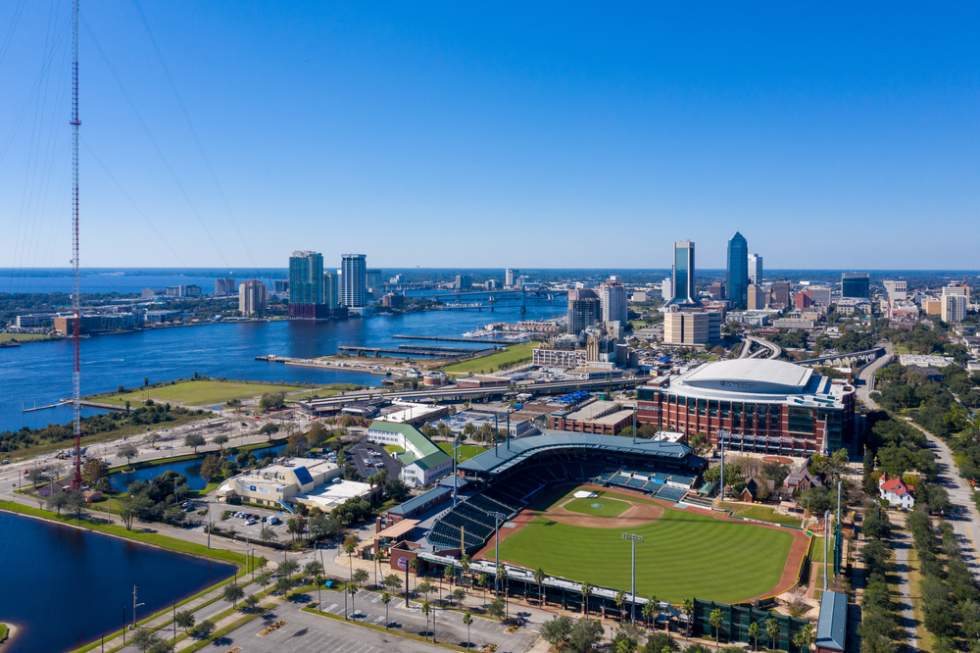One Riverside
- 55 units available
- Studio • 1 bed • 2 bed • 3 bed
- Amenities
In unit laundry, Patio / balcony, Hardwood floors, Dishwasher, Pet friendly, 24hr maintenance + more

Jacksonville renters are getting a break in 2025 after years of steady increases in apartment prices. According to our latest research, the city’s rents are down year over year by approximately 2.3%. A combination of new construction, higher vacancy rates, and a general slowdown in demand has cooled rent prices this year in many outstanding neighborhoods. While Jacksonville neighborhoods near the Beaches and the riverfront remain in high demand, there are still plenty of affordable pockets for renters who know where to look.
We used our latest data to break down the cheapest neighborhoods in Jacksonville, using Apartment List’s verified July 2025 rent data. Whether you’re a remote worker, a recent grad, or someone looking to downsize, these neighborhoods deliver lower-than-average rent without sacrificing quality of life.
We’ll start with a quick rent snapshot, walk through our affordability methodology, and then profile four core affordable neighborhoods. We also included four bonus picks that offer serious value just above our budget cutoff.
In this guide, you’ll also find smart renter strategies, a breakdown of costs, and answers to FAQs to help you make your move.

As of July 2025, the average rent across all unit types in Jacksonville is $1,668 per month, while one-bedrooms average $1,445 monthly. Our data places Jacksonville well below the national average of $2,117, making it one of the more affordable big cities in Florida. Jacksonville is also the largest city by land area in the contiguous United States.
Here’s a quick breakdown of average Jacksonville rents by unit size:
While trendy neighborhoods like Riverside and San Marco remain Jacksonville’s priciest, renters willing to look a few miles beyond the Urban Core can score bigger units, better deals, and even some new construction incentives and amenities.
Jacksonville’s growth hasn’t slowed much in the last few years. Remote workers relocating from pricier metro areas, retirees settling in, and first-time renters priced out of homeownership all contribute to the strong demand in Jacksonville. However, the supply is finally catching up, especially in Westside and Southside.
Rents are rising the fastest in neighborhoods with beach access, top-rated schools, or easy access to central job hubs. Thanks to an increase in the development and lease-up activity, renters have more power to negotiate their lease agreements and more opportunities to stretch their budget to the Jacksonville neighborhoods they prefer. “Lease-up” refers to the early stage of new buildings when managers offer waived fees or a month of free rent to fill units quickly.
Budget-friendly neighborhoods in Jacksonville aren’t just for renters watching their wallets. They also appeal to:
Rents in the center of Jacksonville and the trendiest neighborhoods are still climbing, but these lower-cost alternatives offer a smart balance of price, space, and accessibility.
Even with a growing supply, Jacksonville’s rental market remains competitive. Compared to other major metros in Florida, like Miami, Tampa, and Orlando, Jacksonville remains the most affordable large city throughout the state. Here’s a breakdown of the data:
| City | Average One-Bedroom Rent | Cost of Living Index* |
|---|---|---|
| Jacksonville, FL, Metro | $1,445 | 100 |
| Miami, FL | $2,743 | 118.9 |
| Orlando, FL | $1,823 | 106.0 |
| Tampa | $1,974 | 104.2 |
*Cost of living data is sourced from Sperling’s BestPlaces.
Despite the demand, rental prices in Jacksonville vary dramatically by neighborhood. While some areas clock in near or above $1,600 for a one-bedroom, others sit $300 to $500 below that figure, which makes Jacksonville one of the few places in Florida where it’s still possible to find a deal on a great apartment.
We used the following data and rules to identify Jacksonville’s cheapest neighborhoods:
We didn’t just look at price points in our round-up of the cheapest neighborhoods in Jacksonville. Each budget neighborhood also had to meet a baseline for livability standards:
Here’s a look at our budget picks and what to expect from each of these Jacksonville neighborhoods.
These four neighborhoods offer the lowest average one-bedroom rents in the city while still delivering solid livability and location perks.
These four Jacksonville neighborhoods are just slightly above our $1,499 threshold, but they still offer great value, newer buildings, or excellent locations for discerning renters.
Finding an affordable apartment isn’t just about luck; you also need to use the right filters. When you log onto Apartment List, use:
Setting custom alerts is especially helpful in today’s market. You’ll get notified the second a match pops up, which is critical for budget-friendly units, which tend to go fast.
Even with a good deal on rent, remember that you need to keep other housing costs in check to stretch your budget a little further. Try these tips:
The best time to score a deal in Jacksonville is between November and February, when vacancies rise and landlords are more flexible. Ask about:
Bring some recent comps of the latest rents and nearby apartments from Apartment List to your lease meeting. Your savvy strategy shows you’ve done your homework and makes your negotiation more likely to succeed.
Rents in Jacksonville fell about 2.3% year over year in 2025, faster than the national average. So, if you’re a renter looking to score a deal in one of these budget neighborhoods, now is the time to look.
Yes. Some of these neighborhoods include low-income housing tax credit (LIHTC) properties or accept Section 8 vouchers. You can check with the Jacksonville Housing Finance Authority for programs in your ZIP code.
You can live in some parts of Jacksonville without a car. Baymeadows, Windy Hill, and parts of Arlington have decent Jacksonville Transportation Authority coverage, but Jacksonville is still car-centric. If you're car-free, focus on areas near Beach Boulevard or Southside.
Most neighborhoods on this list are 25 to 40 minutes from Downtown by car. Transit times are often longer, so proximity to major roads like Interstate 295 and Beach Boulevard matters.
One-bedroom units in these neighborhoods range from 650 to 850 square feet, depending on the building’s age and amenities.
Try to move in late fall or early winter (November through February) for the best deals. Landlords are also more willing to offer perks when demand dips.
The 30% rule recommends spending no more than 30% of your gross monthly income on rent and utilities. It’s a solid baseline, though Jacksonville renters often stretch closer to 35%. Stick close to 30% when possible for long-term flexibility.
After falling 2.3% year-over-year, rents may go back up in 2026, but it depends. As new construction slows, prices could tick back up, especially in Southside and around the Beaches. If you find a good deal now, it may be worth locking in a longer lease.

In unit laundry, Patio / balcony, Hardwood floors, Dishwasher, Pet friendly, 24hr maintenance + more
In unit laundry, Patio / balcony, Dishwasher, Pet friendly, Parking, Stainless steel + more